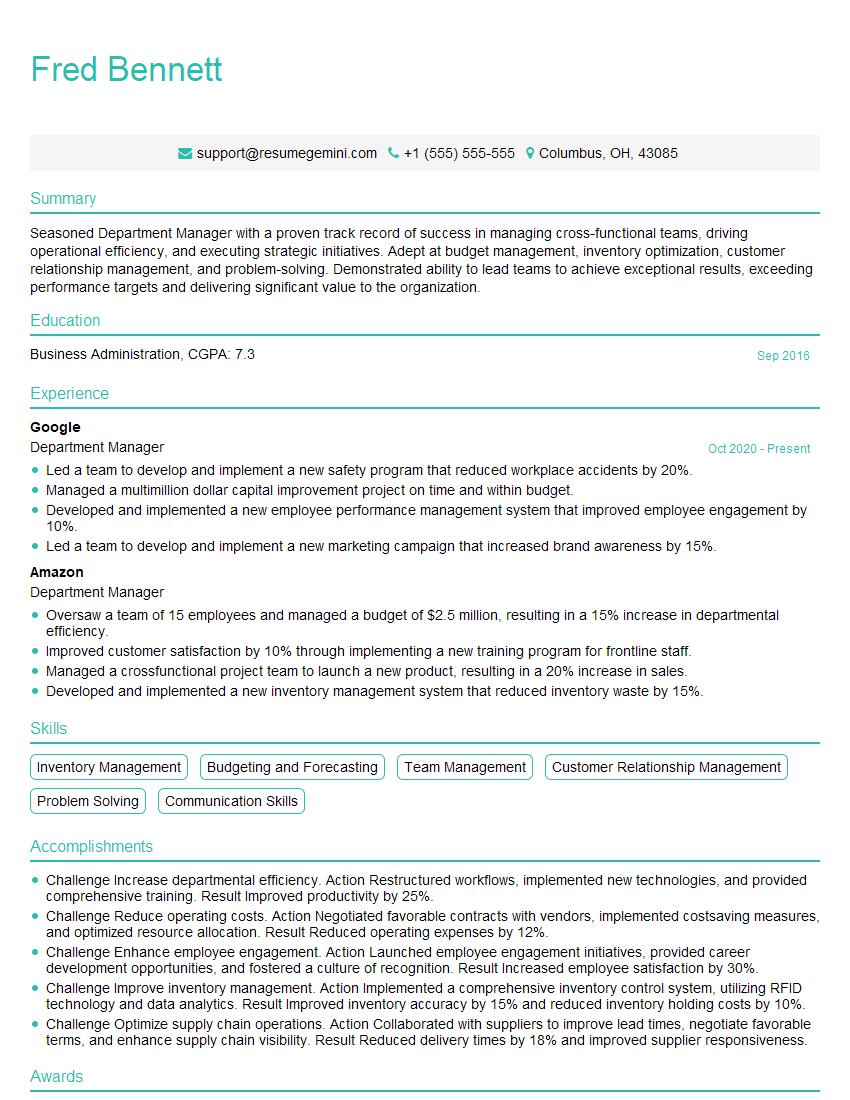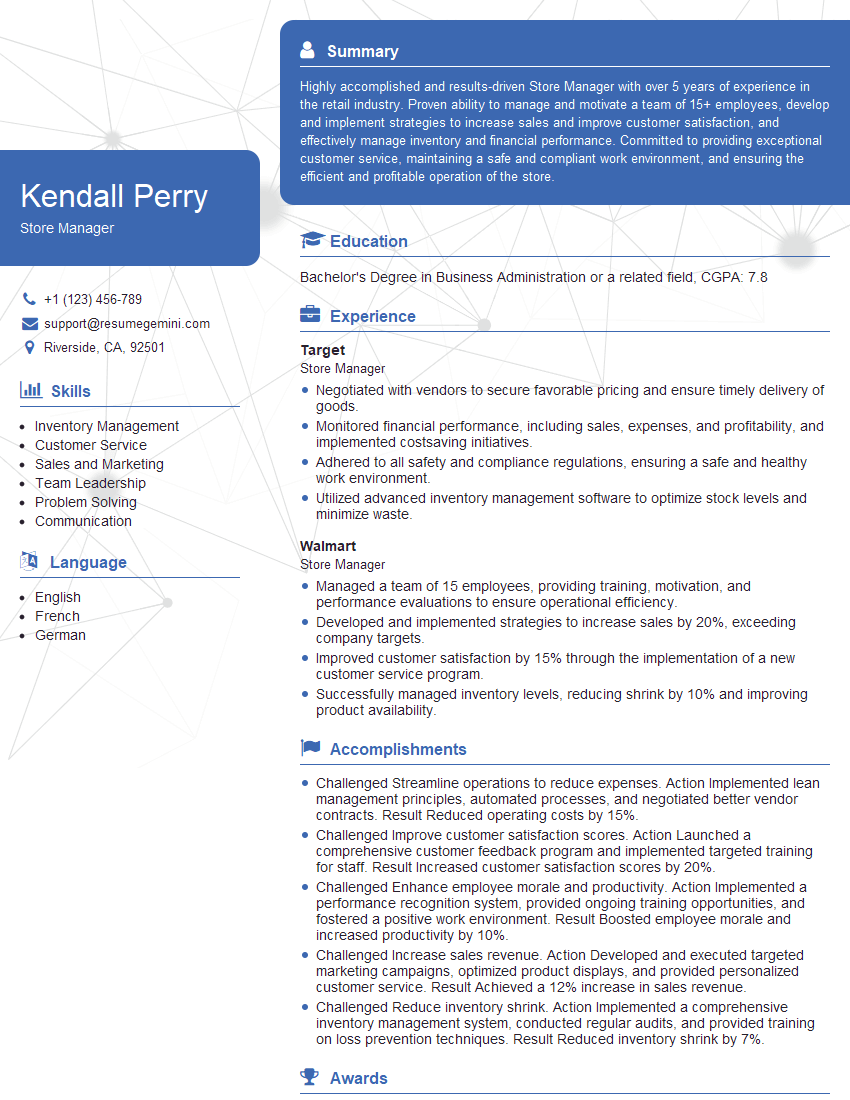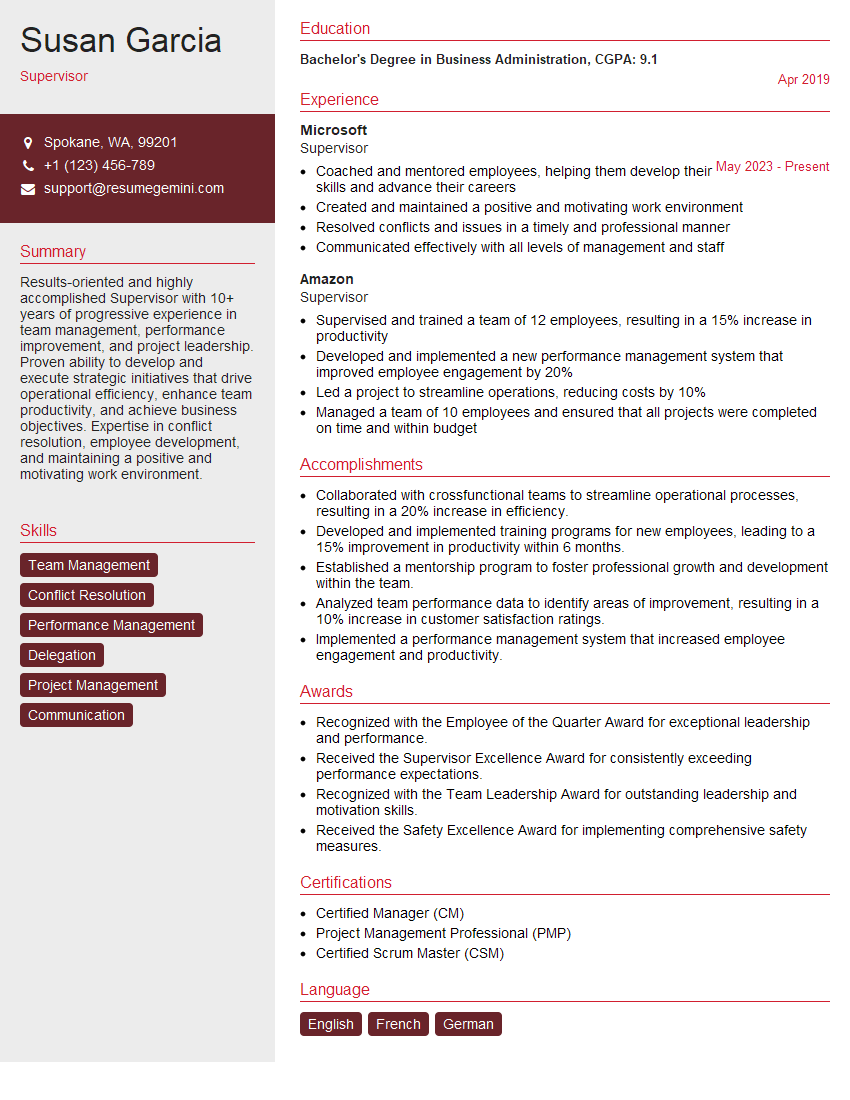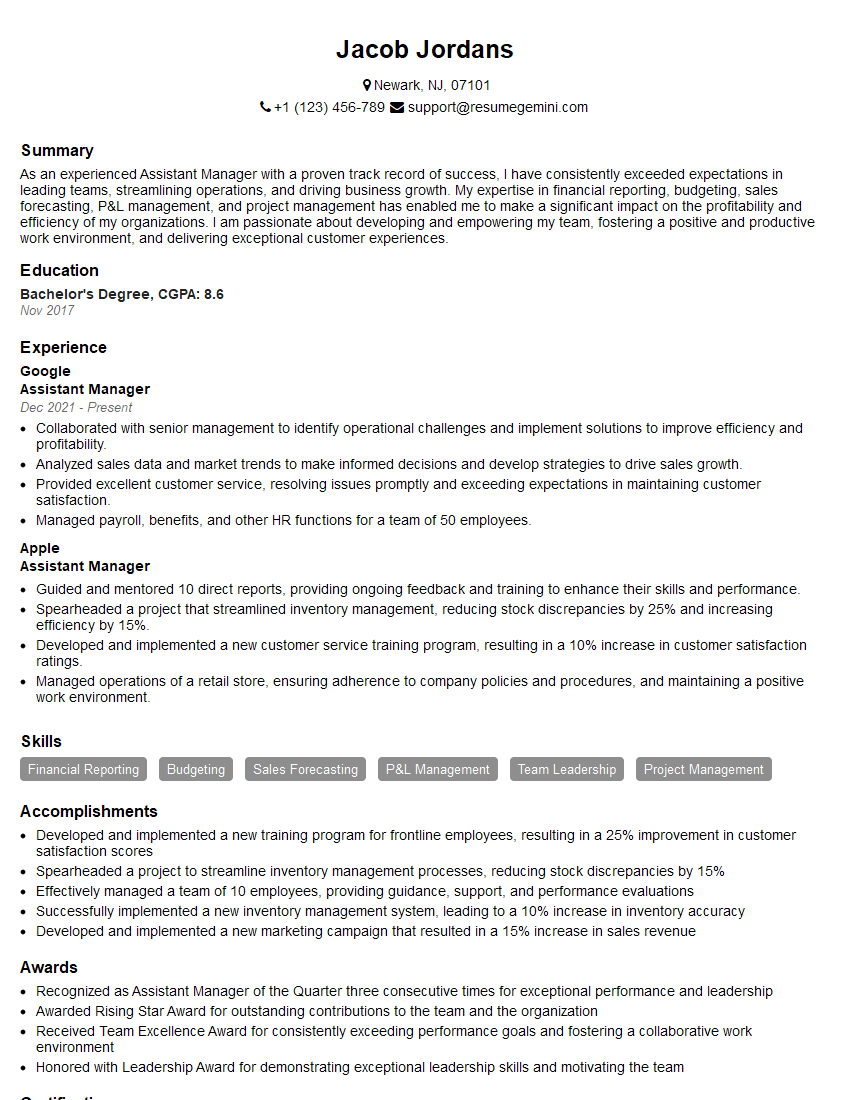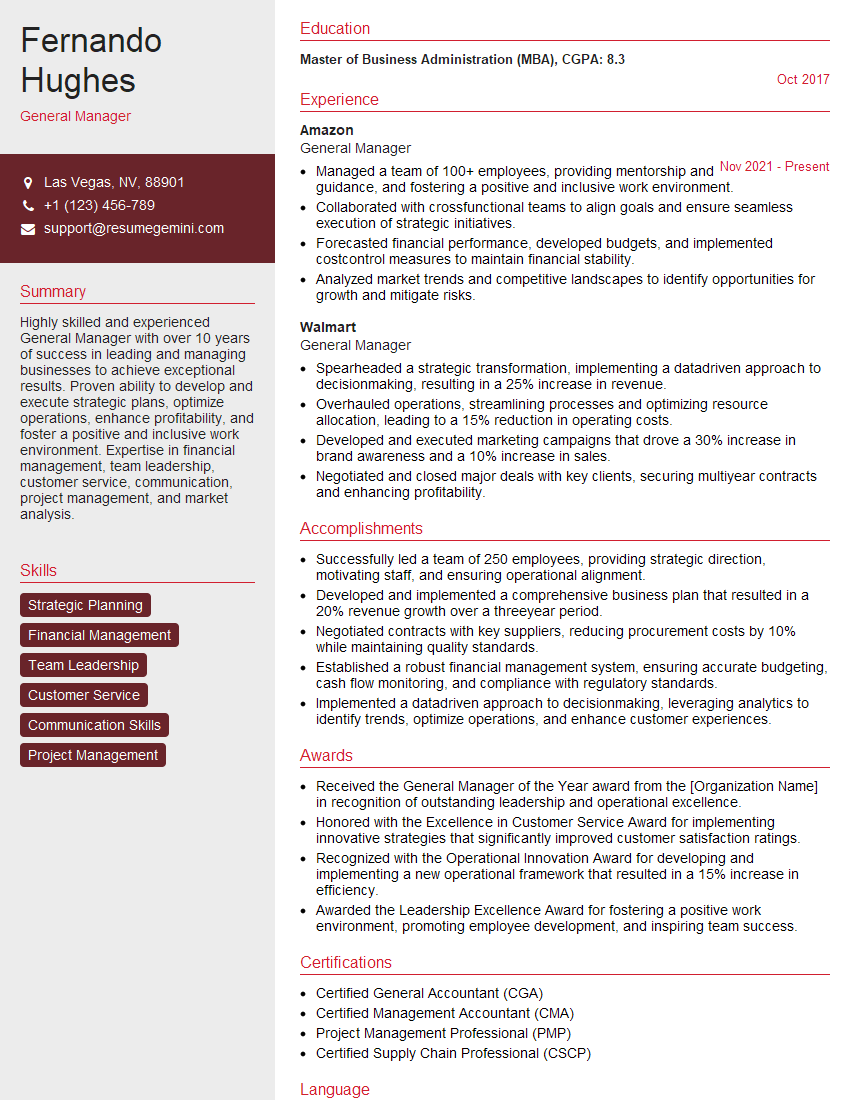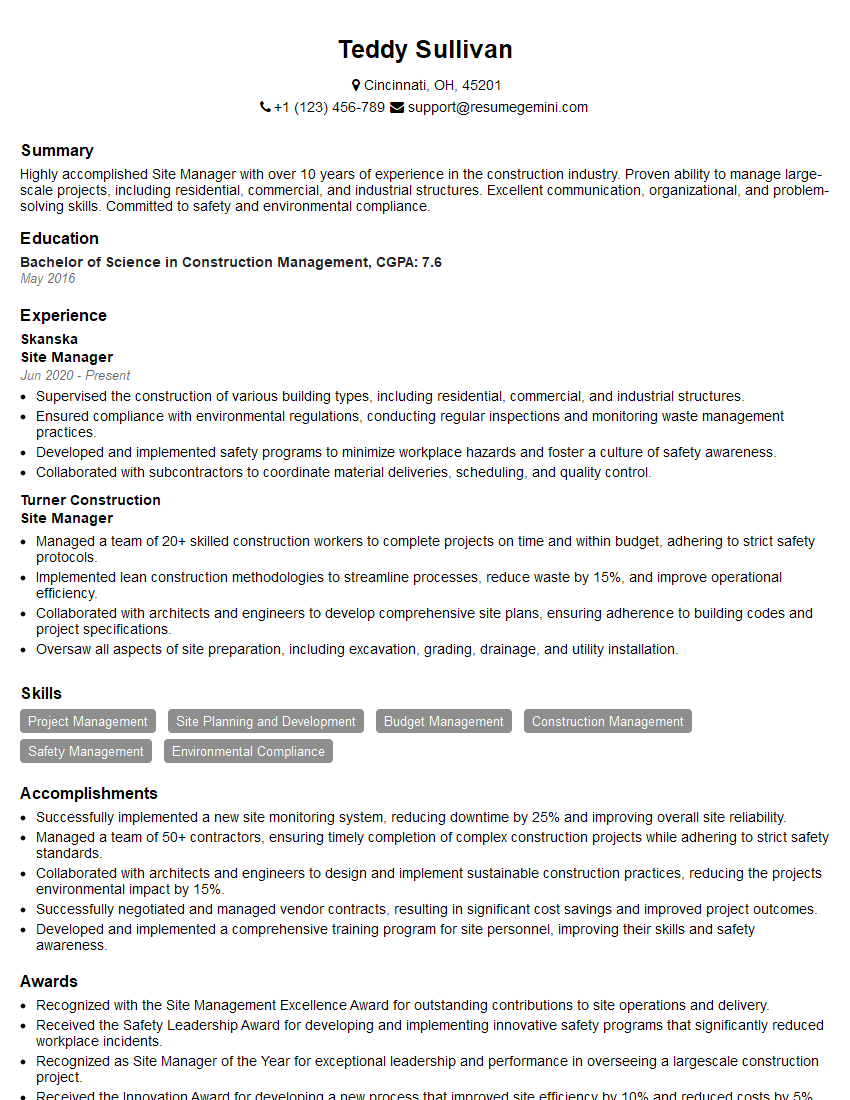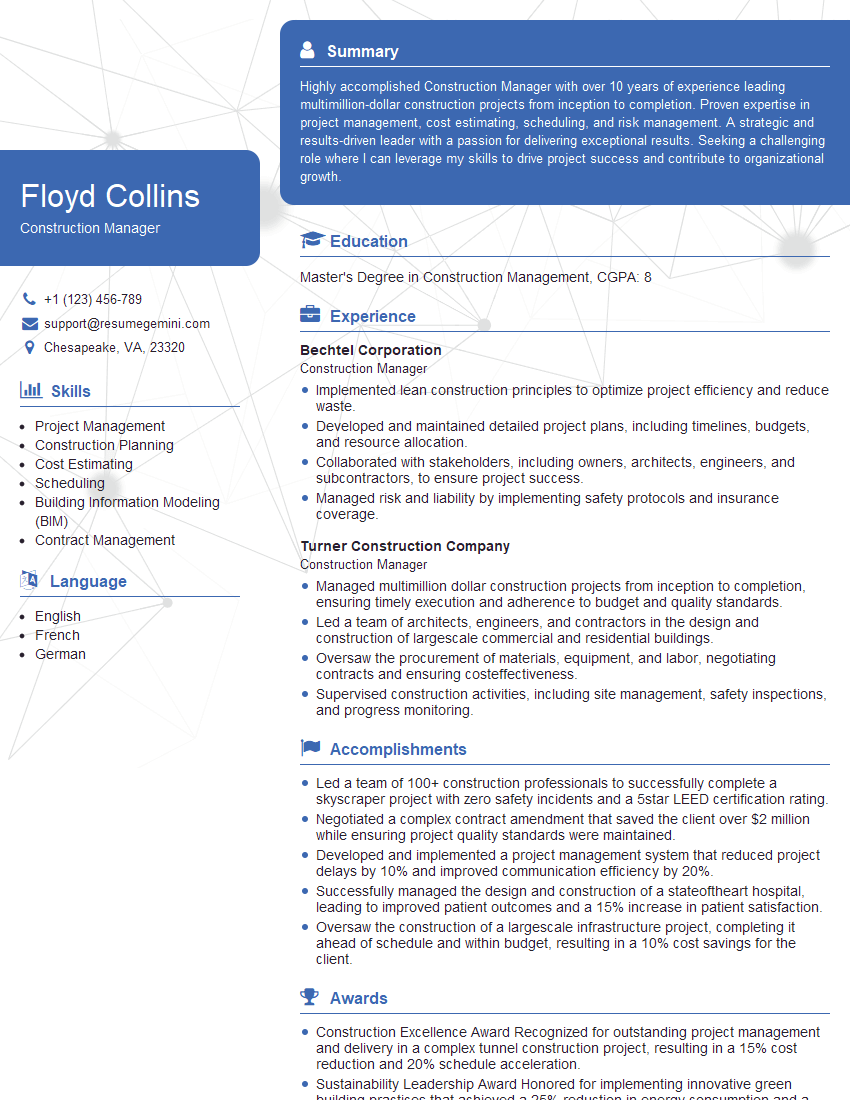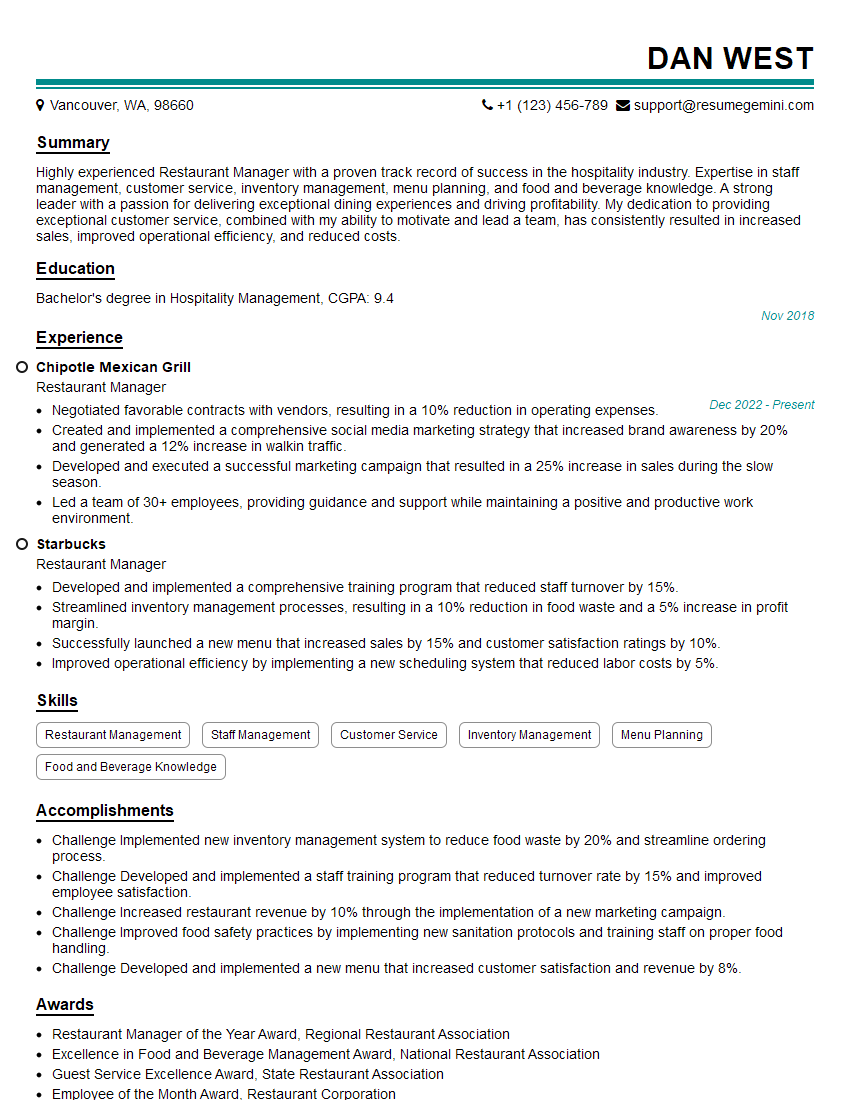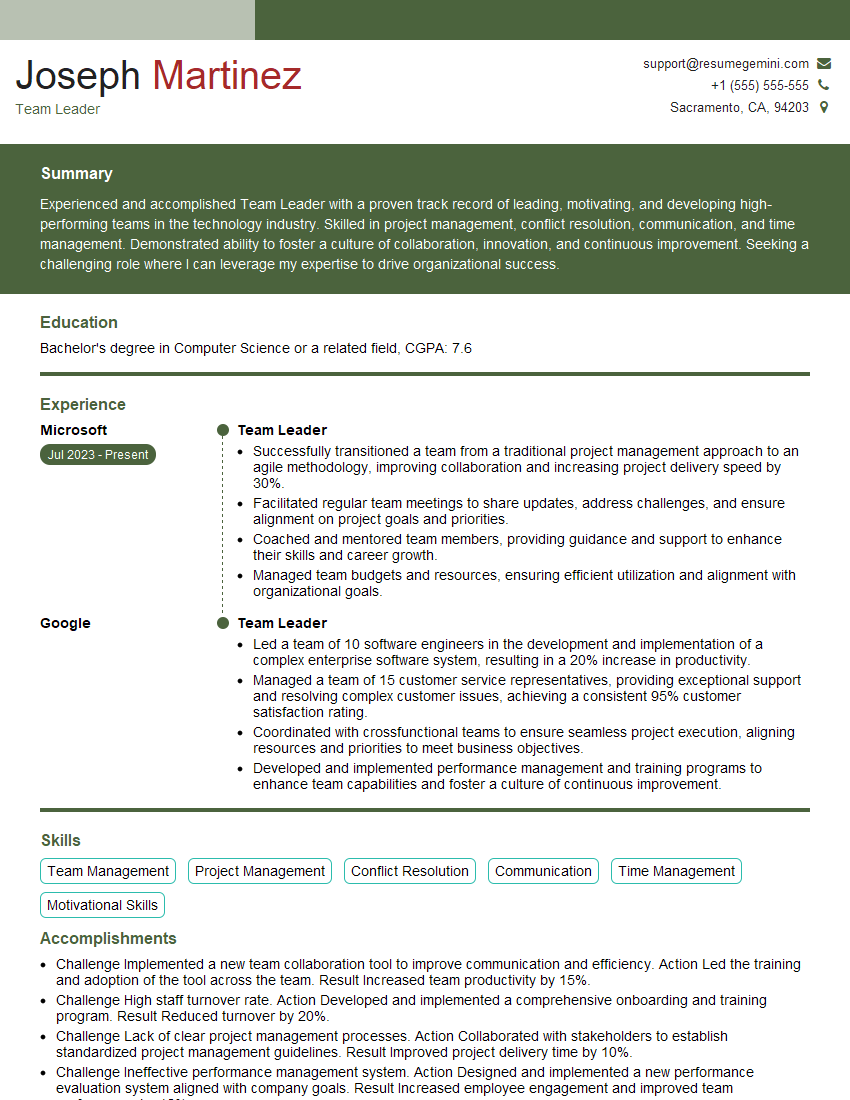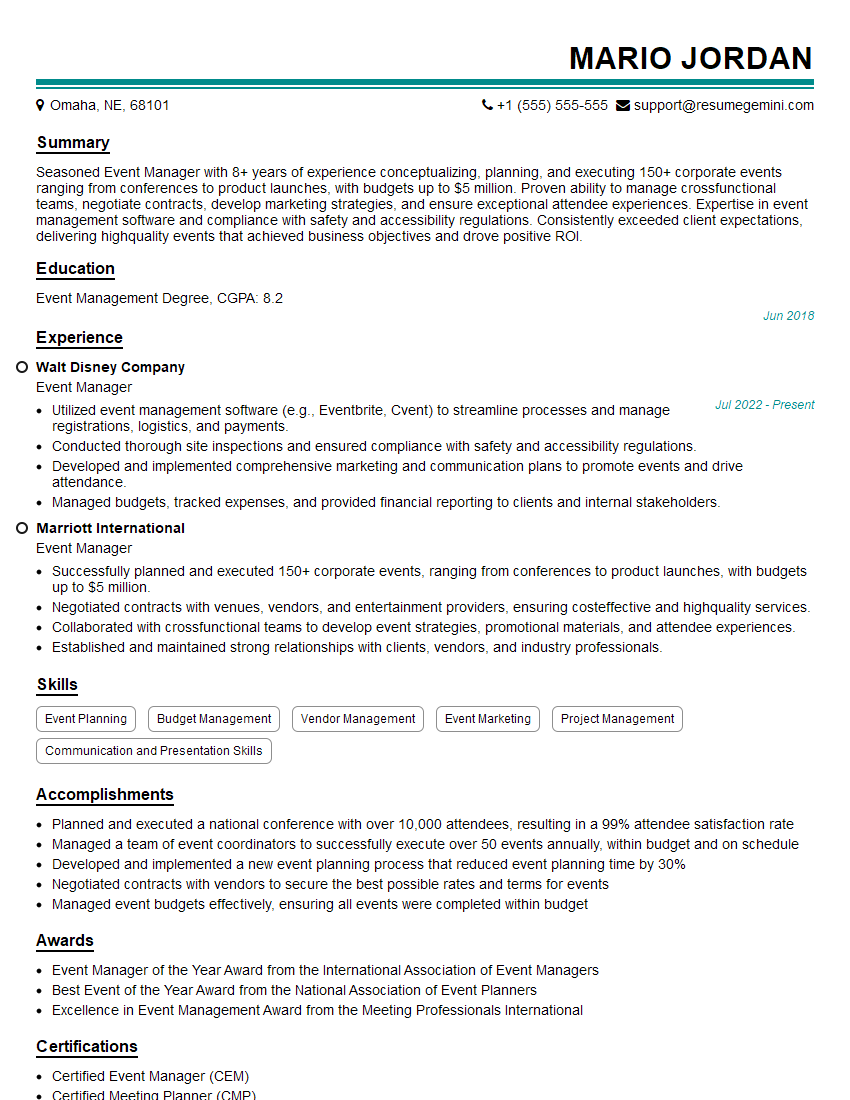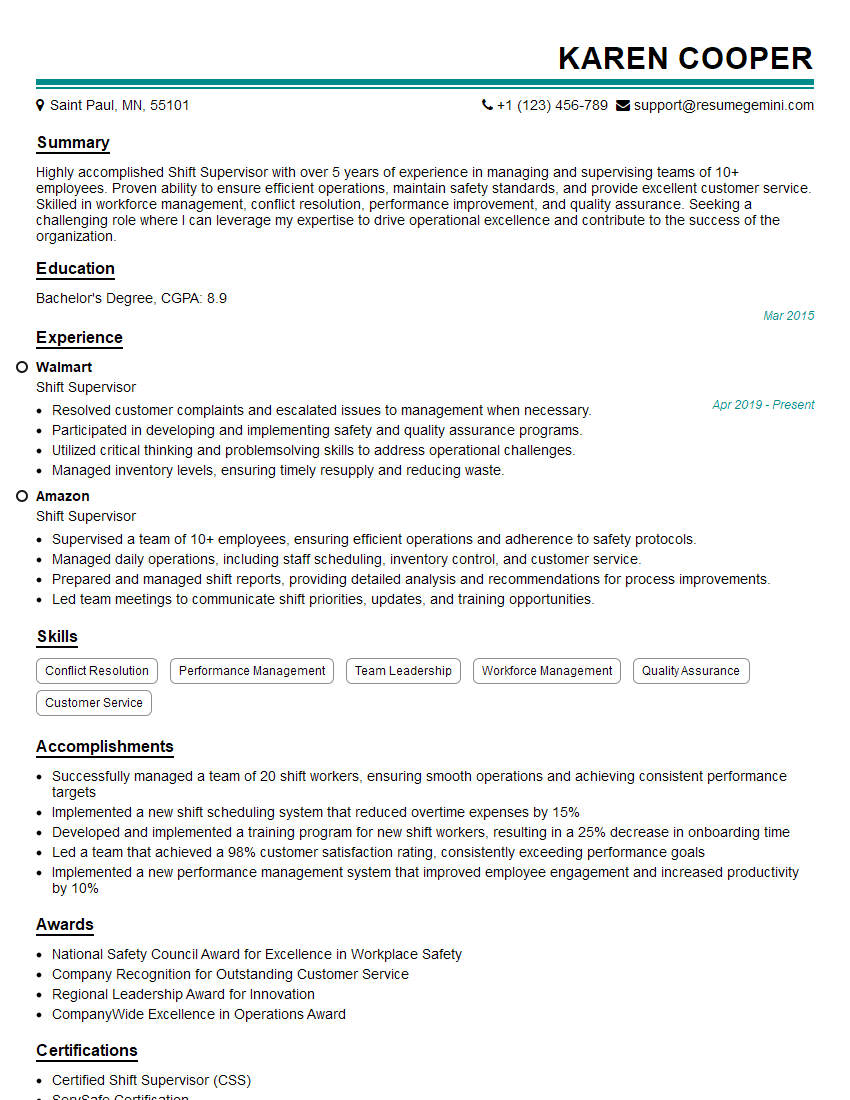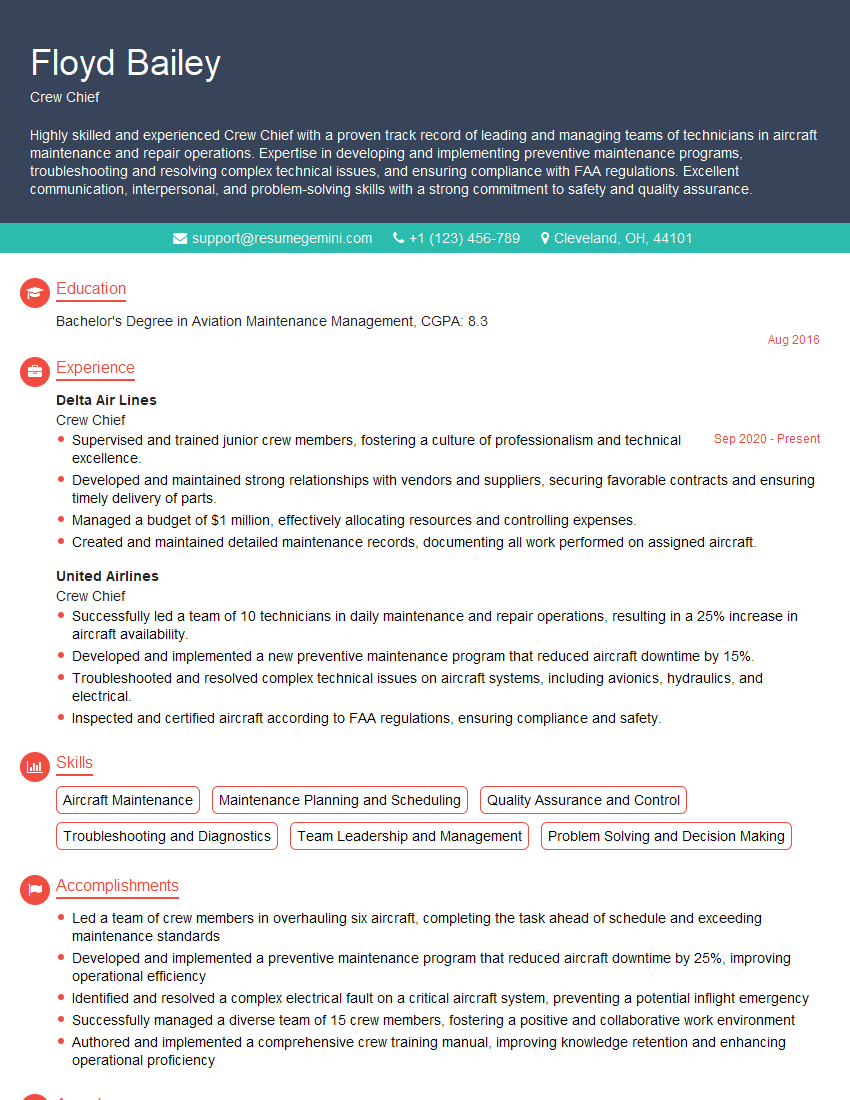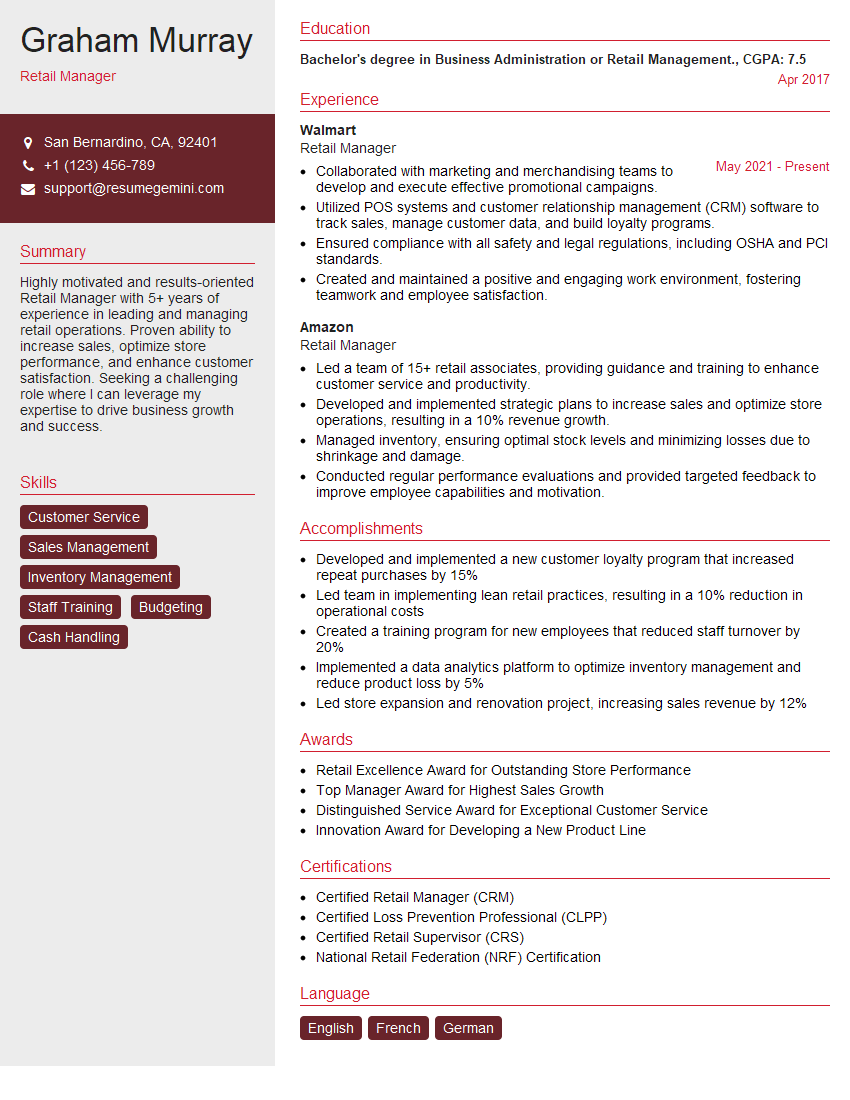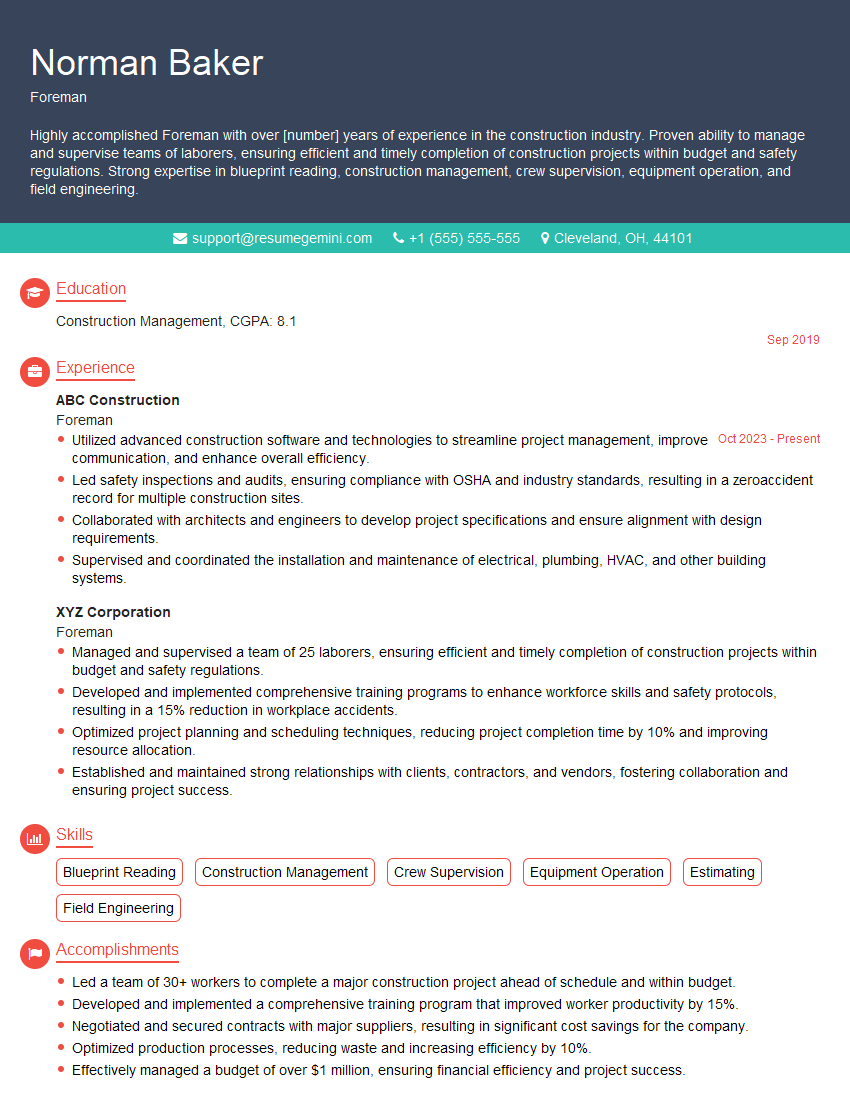Cracking a skill-specific interview, like one for Communicated effectively with supervisors and crew members, requires understanding the nuances of the role. In this blog, we present the questions you’re most likely to encounter, along with insights into how to answer them effectively. Let’s ensure you’re ready to make a strong impression.
Questions Asked in Communicated effectively with supervisors and crew members Interview
Q 1. Describe a time you had to deliver difficult news to your supervisor.
Delivering difficult news requires tact, empathy, and a clear, concise approach. I always prepare beforehand, outlining key points and anticipating potential reactions. For example, when a project I was managing experienced unforeseen delays impacting the deadline, I scheduled a meeting with my supervisor. I started by acknowledging the situation and taking responsibility for the setback, avoiding blame. Then, I clearly explained the reasons for the delay, providing supporting data. I followed this by presenting a revised timeline with mitigation strategies to minimize further impact. Crucially, I actively listened to my supervisor’s concerns and addressed them directly, showing my commitment to finding solutions. The meeting concluded with a plan of action and a clear understanding of next steps. The key is to be transparent, proactive, and solution-oriented, focusing on mitigating the negative impact rather than dwelling on the problem.
Q 2. How do you ensure clear and consistent communication within your team?
Clear and consistent communication within a team is paramount. I achieve this through multiple channels and strategies. Firstly, I establish clear communication protocols at the project’s outset. This includes defining preferred communication methods (e.g., daily stand-up meetings, project management software, email for formal updates), outlining response times, and clarifying roles and responsibilities. Secondly, I foster open dialogue, encouraging team members to share ideas, concerns, and challenges freely. Regular team meetings are crucial, providing a platform for updates, discussions, and collaborative problem-solving. Thirdly, I utilize project management tools like Jira or Asana to centralize information, track progress, and ensure everyone is aligned. Finally, I emphasize active listening and feedback, ensuring that everyone understands the messages and has opportunities to ask clarifying questions. This proactive and multifaceted approach ensures consistency and transparency, minimizing misunderstandings and promoting a collaborative environment.
Q 3. Explain your approach to resolving communication breakdowns within a team.
Communication breakdowns are inevitable, but addressing them effectively is vital. My approach starts with identifying the root cause of the breakdown. This might involve conducting one-on-one conversations with team members to understand their perspectives. Once the issue is identified (misunderstanding, lack of clarity, conflicting information, etc.), I work collaboratively to find a solution. This could involve clarifying expectations, providing additional training or resources, or implementing new communication protocols. For example, if a misunderstanding arose from unclear instructions, I would revise the instructions, ensuring they’re concise, clear, and easily understood by all. If the breakdown stems from personality clashes, I facilitate constructive dialogue, focusing on finding common ground and solutions that address everyone’s concerns. The goal is to not just resolve the immediate issue but to implement preventative measures to avoid future breakdowns.
Q 4. How do you adapt your communication style to different personality types?
Adapting communication style is essential for effective teamwork. I assess individual communication preferences and styles by observing their interactions, listening to their feedback, and understanding their working styles. For example, someone who prefers concise emails might receive short, to-the-point updates, while someone who benefits from visual aids might receive presentations or diagrams. I’m also mindful of body language and tone, adjusting my approach to ensure the message is received positively and without creating conflict. For introverted individuals, I might prefer written communication or one-on-one meetings to foster a comfortable exchange. With extroverted colleagues, more interactive group discussions could be more effective. This personalized approach builds trust and rapport, ensuring each team member feels understood and valued. The key is to be flexible and sensitive to individual differences while maintaining clear and consistent communication overall.
Q 5. Describe a situation where you had to communicate complex information to a non-technical audience.
Communicating complex technical information to a non-technical audience requires simplification and visualization. I once had to explain a complex software algorithm to a group of stakeholders with limited technical backgrounds. Instead of using technical jargon, I used analogies and metaphors to illustrate the concept. For example, I compared the algorithm’s process to a simple recipe, breaking down each step in a relatable way. I also used visual aids like flowcharts and diagrams to visually represent the process, making the information easier to grasp. I kept the language simple and avoided technical terms unless absolutely necessary. If technical terms were unavoidable, I provided concise definitions. Finally, I encouraged questions and provided clear answers, addressing any misunderstandings immediately. The result was a well-understood presentation, even for the non-technical audience.
Q 6. How do you handle disagreements or conflicts within your team regarding communication?
Disagreements regarding communication should be addressed constructively and promptly. My approach focuses on active listening, understanding each party’s perspective, and finding common ground. I encourage open dialogue, creating a safe space for individuals to express their concerns without fear of judgment. I focus on the issue at hand, avoiding personal attacks or assigning blame. Often, the root cause of the conflict isn’t the communication itself, but a misunderstanding of roles, goals, or expectations. Clarifying these points often resolves the disagreement. If a solution isn’t readily apparent, I facilitate a structured discussion, guiding team members toward a mutually acceptable solution. Compromise and collaboration are key to reaching a positive resolution. Documentation of the agreement and any revised communication protocols are crucial to prevent future conflicts.
Q 7. What strategies do you use to keep your team informed about project updates?
Keeping a team informed about project updates is crucial for maintaining momentum and preventing misunderstandings. I employ multiple strategies to ensure consistent updates. Regular team meetings, as mentioned earlier, are a primary method. Project management software acts as a central hub for updates, allowing team members to track progress, view deadlines, and access relevant documentation. I also utilize email for specific updates or announcements, ensuring all team members are included. For large projects with many stakeholders, I may use newsletters or briefings, depending on the audience and the type of information being shared. I make a point of being transparent about delays or challenges, explaining the reason for the change and the plan to address it. The key is consistency; regular, clear communication builds trust and keeps the team aligned.
Q 8. How do you solicit feedback from your team members and supervisors?
Soliciting feedback is crucial for continuous improvement. I employ a multi-faceted approach. Firstly, I conduct regular one-on-one meetings with each team member, creating a safe space for open dialogue. I start by asking open-ended questions like, “What are your thoughts on our recent project?” or “What challenges have you encountered, and how can we better support you?” Secondly, I utilize anonymous surveys or feedback forms for broader team input, especially on sensitive topics. Finally, I actively listen during team meetings, encouraging participation through techniques such as brainstorming sessions and round-robin discussions. For supervisors, I schedule formal performance reviews and also seek informal feedback throughout the project lifecycle, asking for their insights on my performance and the team’s progress.
Example: During a project review, instead of simply asking “How did the project go?”, I’d ask, “What were the biggest successes and challenges in executing this project? What could we have done differently to improve the outcome?” This encourages more thoughtful responses.
Q 9. How do you utilize various communication channels (email, meetings, etc.) effectively?
Effective communication requires selecting the right channel for the right message. Emails are ideal for distributing information widely, providing a record, and facilitating asynchronous communication. I utilize them for updates, reports, and sharing documents. For instance, a weekly progress report to my supervisor would be sent via email. Meetings, particularly face-to-face or video conferences, are vital for complex discussions, brainstorming, and fostering team cohesion. Here, I use a clear agenda to keep the discussion focused and productive. Instant messaging platforms are perfect for quick questions or urgent updates, promoting immediate responses. For instance, If I need a clarification on a specific task during the day, instant messaging can be beneficial.
I ensure clarity in all channels by using concise language, structuring information logically, and actively seeking clarification when needed. I avoid relying on just one communication method; combining channels enhances comprehension and ensures everyone receives the message.
Q 10. Describe your approach to proactive communication.
Proactive communication prevents problems before they arise. It involves anticipating potential issues and addressing them early. For example, if I anticipate a delay in a project, I would inform my supervisor and team members well in advance, outlining the potential impact and suggesting mitigation strategies. I also regularly provide updates on project progress even if there are no significant changes, keeping everyone informed and involved. This builds trust and prevents surprises. It also involves proactively seeking information—such as asking clarifying questions early to avoid misunderstandings.
Example: Before a critical meeting, I would proactively prepare a detailed agenda and share it with attendees beforehand, ensuring everyone is on the same page. If I foresee a potential conflict, I’d address it directly and respectfully before it escalates.
Q 11. How do you manage communication in high-pressure situations?
High-pressure situations demand clear, concise, and calm communication. My approach centers on maintaining a structured workflow and clear communication protocols. I establish concise roles and responsibilities to avoid confusion and duplication of effort. I frequently check in with team members to assess their workload and morale, providing support where necessary. When delivering updates, I focus on essential information, avoiding unnecessary details. I encourage open communication, emphasizing active listening, empathy, and remaining calm. During stressful times, I consciously practice clear, concise speech patterns.
Example: During a crisis, I would prioritize communication channels, perhaps using instant messaging for critical updates and holding a dedicated meeting once the immediate situation has been stabilized.
Q 12. How do you ensure confidentiality when communicating sensitive information?
Confidentiality is paramount. I always adhere to company policies and relevant regulations regarding sensitive information. When handling confidential material, I use secure communication channels (e.g., encrypted emails) and restrict access to only authorized individuals. I clearly communicate the confidential nature of information to all involved parties, emphasizing the importance of discretion. I avoid discussing sensitive topics in public areas or using unsecured devices. Documentation of sensitive information is kept in secure, password-protected systems.
Example: When discussing client financial details, I would always use a secure platform and confirm the recipient’s authorization before sharing any information.
Q 13. How do you give and receive constructive criticism?
Giving and receiving constructive criticism is a skill that requires empathy and a focus on improvement. When giving feedback, I use the “sandwich method”: starting with positive feedback, followed by the constructive criticism, and ending with more positive reinforcement. I focus on specific behaviors rather than personal attacks and I provide actionable suggestions for improvement. When receiving criticism, I listen actively, ask clarifying questions to fully understand the perspective, and then reflect on the feedback to identify areas for growth. I avoid defensiveness and strive to engage in a constructive dialogue focused on improvement.
Example: Instead of saying “Your report is messy,” I would say, “Your report contains some valuable insights, however, the formatting could be improved for better clarity. Consider using bullet points and clearer headings for easier navigation.”
Q 14. How do you document important communications to avoid misunderstandings?
Documentation is essential for clarity and accountability. I maintain detailed records of all significant communications, including emails, meeting minutes, and project updates. I utilize version control systems where applicable. These records serve as a reference point for future decisions, conflict resolution, and ensuring consistency in communication. I strive for thorough and accurate documentation, using clear and concise language. These records are stored securely according to company policy.
Example: After each team meeting, I create and distribute minutes that summarize key discussions, decisions made, and action items assigned to specific team members. This ensures accountability and maintains a record of the meeting’s progress.
Q 15. Have you ever had to escalate a communication issue to upper management? Describe how.
Escalating a communication issue requires a strategic approach. It’s not something to do lightly, as it can disrupt workflows and create unnecessary tension. I typically try all other avenues first – direct conversation, clarification, and perhaps a follow-up email – before involving upper management. However, if a critical problem persists despite my best efforts to resolve it internally, I document everything meticulously. This documentation includes dates, times, individuals involved, attempts made at resolution, and the ongoing impact of the unresolved communication issue.
For example, I once had a situation where a crucial design specification was miscommunicated between the design team and the manufacturing team, leading to significant delays and potential cost overruns. After several attempts to clarify the misunderstanding directly with the teams involved, I compiled a detailed report highlighting the conflicting information, the attempts at resolution, and the projected financial impact of the delay. I then presented this report to my supervisor, clearly explaining the situation and recommending a specific action plan for preventing future miscommunications of this nature. This led to a company-wide review of our communication protocols and improved training for all personnel.
Career Expert Tips:
- Ace those interviews! Prepare effectively by reviewing the Top 50 Most Common Interview Questions on ResumeGemini.
- Navigate your job search with confidence! Explore a wide range of Career Tips on ResumeGemini. Learn about common challenges and recommendations to overcome them.
- Craft the perfect resume! Master the Art of Resume Writing with ResumeGemini’s guide. Showcase your unique qualifications and achievements effectively.
- Don’t miss out on holiday savings! Build your dream resume with ResumeGemini’s ATS optimized templates.
Q 16. How do you use nonverbal communication to enhance your message?
Nonverbal communication is as crucial as verbal communication, often even more so. It significantly impacts how my message is received and understood. I use nonverbal cues consciously and strategically. Maintaining consistent eye contact shows engagement and sincerity. My posture – upright and attentive – communicates confidence and professionalism. My facial expressions reflect my tone; a smile conveys approachability, while a serious expression indicates the gravity of the matter. I also use hand gestures sparingly, ensuring they complement, not distract from, my words. For instance, when explaining a complex process, I might use hand gestures to visually represent the different steps, making the explanation clearer and more engaging.
Q 17. Describe your experience using communication tools like project management software.
I’m proficient in using various project management software, including Asana, Trello, and Monday.com. These tools are invaluable for streamlined communication. I utilize them to assign tasks, set deadlines, share files, and provide updates. The real-time collaboration features allow for instant feedback and prevent miscommunications regarding project status. For instance, in Asana, I use comments to clarify tasks, provide instructions, and document progress. I leverage the @mention feature to directly notify team members of important updates. The ability to track project timelines and individual contributions provides transparency and accountability, fostering a more effective communication flow. This is vital for staying organized and ensuring everyone is on the same page.
Q 18. How do you ensure all team members understand their roles and responsibilities?
Clearly defining roles and responsibilities is paramount for effective teamwork and communication. I achieve this through a combination of methods. First, I ensure there’s a clear job description or task outline for each team member, outlining their specific responsibilities and how they contribute to the larger project goals. Second, I hold regular team meetings to discuss roles, address any ambiguities, and foster open dialogue. I also encourage team members to communicate directly with each other and to use project management software effectively to track progress and assignments. Open communication channels, along with clear documentation, help to avoid confusion and improve overall performance.
For example, at the start of each project, I create a RACI matrix (Responsible, Accountable, Consulted, Informed). This ensures that each task has a clearly defined owner, while also specifying who needs to be consulted or informed regarding that task’s progress. This transparency makes sure everyone understands their roles and prevents duplicated effort or overlooked tasks.
Q 19. How do you handle situations where communication barriers exist due to language or cultural differences?
Communication barriers due to language or cultural differences require sensitivity and proactive measures. I start by creating a welcoming and inclusive environment where everyone feels comfortable contributing. When language is a barrier, I utilize translation tools and, if possible, bilingual team members. Beyond translation, it’s crucial to understand the nuances of different cultures. For example, direct communication might be considered rude in some cultures, while in others it’s expected. I adapt my communication style accordingly, being mindful of body language, tone, and overall approach. I find that building personal connections with team members from diverse backgrounds fosters understanding and trust, helping overcome communication challenges. Active listening and seeking clarification are essential in these situations.
Q 20. How do you build rapport and trust with your team members and supervisor?
Building rapport and trust is a fundamental aspect of effective communication. It’s achieved through consistent effort and genuine interaction. I prioritize open and honest communication, both upwards and downwards. With my supervisor, I maintain regular updates on project progress and proactively address any potential issues. I seek feedback consistently, demonstrating a willingness to learn and improve. With team members, I foster a collaborative environment, encouraging open discussion and active listening. I celebrate team successes and offer support during challenges. Showing respect for their opinions, acknowledging their contributions, and creating a safe space for feedback all contribute to building strong, trusting relationships.
Q 21. Describe a time you successfully resolved a communication-related problem.
In a previous project, we faced a significant delay due to a misunderstanding about the project timeline. The marketing team had misinterpreted a deadline, resulting in a delay in the launch of a new product. To resolve this, I initiated a series of meetings, involving all stakeholders including marketing, development, and sales. I facilitated open discussion, allowing everyone to express their perspective. We collaboratively reviewed the project timeline, clarifying each step and assigning clear owners. I used visual aids, like a Gantt chart, to illustrate the dependencies and the impact of each delay. Through this collaborative effort, we identified the root cause of the miscommunication and implemented measures to improve communication clarity for future projects, eventually delivering the product on schedule with minimal disruption. The key to success was fostering open dialogue and finding a collaborative solution instead of assigning blame.
Q 22. How do you measure the effectiveness of your communication strategies?
Measuring the effectiveness of communication strategies isn’t about gut feeling; it’s about data-driven assessment. I utilize a multi-faceted approach. Firstly, I track key performance indicators (KPIs) relevant to the communication goal. For example, if the goal was to improve safety protocols, I’d track the number of safety incidents before and after implementing the new communication strategy. If the goal was to boost team morale, I’d conduct anonymous surveys measuring team satisfaction and engagement. Secondly, I actively solicit feedback. This includes formal feedback mechanisms like surveys and reviews, but also informal methods such as regular check-ins with team members and supervisors. Finally, I analyze communication channel usage – looking at response rates, participation levels, and the overall effectiveness of the chosen medium (email, meetings, instant messaging, etc.). Combining quantitative data (KPIs) with qualitative data (feedback) provides a comprehensive understanding of the communication strategy’s success.
For instance, in a previous role, we implemented a new project management system coupled with daily stand-up meetings. By tracking the number of completed tasks on time, along with survey results showing increased team clarity and reduced project delays, we could definitively prove the communication strategy’s effectiveness.
Q 23. What steps do you take to ensure clear and concise written communication?
Clear and concise written communication is crucial for avoiding misunderstandings and ensuring efficient workflow. My approach centers around a few key steps. First, I define my audience. This allows me to tailor the tone, style, and level of detail appropriately. Next, I structure my message logically, using headings, bullet points, and short paragraphs to enhance readability. I utilize active voice and strong verbs to maintain clarity and engagement. Then comes the editing and proofreading phase; this is where grammar and spelling errors are eliminated, and the overall message is refined for precision. Finally, before sending, I read the communication aloud to catch any awkward phrasing or unclear sentences. This process is vital for conveying professionalism and making sure the message is easily understood.
For example, instead of writing ‘The report is currently being worked on by the team,’ I’d write ‘The team is finalizing the report.’
Q 24. How do you handle multiple communication requests simultaneously?
Managing multiple communication requests simultaneously requires a well-organized and efficient approach. I employ a prioritization matrix, listing each request with its urgency and importance. This allows me to tackle the most critical tasks first. Furthermore, I leverage technology to my advantage – using tools like shared calendars, task management software (e.g., Asana, Trello), and email filters to streamline my workflow and prevent tasks from slipping through the cracks. Effective time management techniques, such as time blocking and the Pomodoro technique, help me allocate sufficient time to each request without feeling overwhelmed.
For instance, if I have an urgent request from a supervisor alongside a less urgent request from a team member, the supervisor’s request takes precedence. Utilizing project management software to schedule responses allows for efficient handling of both requests while ensuring that deadlines are met.
Q 25. How do you prioritize communication tasks based on urgency and importance?
Prioritizing communication tasks hinges on understanding the urgency and importance of each request. I use a simple yet effective framework: I visualize my tasks on a matrix with four quadrants: Urgent & Important, Important but Not Urgent, Urgent but Not Important, and Neither Urgent nor Important. Items in the ‘Urgent & Important’ quadrant receive immediate attention, while ‘Important but Not Urgent’ tasks are scheduled strategically. ‘Urgent but Not Important’ tasks might be delegated or postponed if possible. ‘Neither Urgent nor Important’ tasks are often eliminated or delayed. This matrix allows for a clear visual representation of priorities, enabling a more efficient use of my time and resources.
Imagine a scenario where you have a deadline for a critical report (Urgent & Important), a long-term project planning session (Important but Not Urgent), a last-minute request for a minor task (Urgent but Not Important), and a routine email that can be handled later (Neither Urgent nor Important). The matrix would help prioritize the report and then strategically schedule the planning session.
Q 26. Describe your experience conducting effective team meetings.
Effective team meetings are not about just gathering everyone together; they are about achieving specific outcomes. I begin by establishing a clear agenda that’s distributed in advance to ensure everyone is prepared. During the meeting, I encourage active participation from all members, fostering a safe space for open communication and idea sharing. I manage the time effectively, keeping the meeting focused on the agenda items and ensuring that discussions remain productive. Finally, I always summarize key decisions and action items, assigning responsibilities and setting deadlines to ensure accountability. Post-meeting, I distribute minutes to document the discussion and subsequent actions.
In a past project, we used a ’round robin’ approach in our team meetings, ensuring everyone had an opportunity to share updates and concerns before open discussion, which drastically improved meeting productivity and team engagement.
Q 27. How do you provide constructive feedback to improve team performance?
Providing constructive feedback is about fostering growth and improvement, not about criticism. My approach emphasizes the ‘Situation-Behavior-Impact’ (SBI) model. I start by describing the specific situation (‘Situation’), then describe the observed behavior (‘Behavior’), and finally, I explain the impact of that behavior (‘Impact’). This provides a clear and objective context, helping the recipient understand the feedback without feeling personally attacked. I always focus on specific examples rather than generalizations, and I frame my feedback in a positive and supportive manner, offering suggestions for improvement whenever possible. I also encourage a two-way conversation to allow for clarification and mutual understanding.
For example, instead of saying ‘You’re not a good team player,’ I might say, ‘During the last project, I noticed you didn’t participate in the brainstorming session (Situation). As a result, your ideas were not incorporated into the project plan (Impact). Next time, I encourage you to actively participate in brainstorming sessions to ensure your insights are included (Suggestions for Improvement).’
Q 28. How do you leverage technology to improve team communication?
Technology plays a vital role in enhancing team communication. I leverage various tools depending on the context and needs of the team. For example, project management software (Asana, Trello) helps with task assignment, progress tracking, and file sharing, promoting transparency and collaboration. Instant messaging platforms (Slack, Microsoft Teams) enable quick communication and real-time updates. Video conferencing tools (Zoom, Google Meet) facilitate virtual meetings and collaboration, particularly when team members are geographically dispersed. Furthermore, I utilize cloud-based storage (Google Drive, Dropbox) for centralized document storage and easy access to information. The key is to choose the right tool for the job and ensure that the team is adequately trained in its use.
In a previous project, using a project management tool significantly reduced email traffic and improved team coordination by providing a centralized platform for all project-related information and communication.
Key Topics to Learn for “Communicated Effectively with Supervisors and Crew Members” Interview
- Active Listening and Feedback: Understanding how to actively listen to instructions, feedback, and concerns from both supervisors and team members. This includes clarifying instructions and asking questions to ensure complete understanding.
- Clear and Concise Communication: Mastering the art of delivering information clearly and concisely, both verbally and in writing. This includes adapting your communication style to your audience (e.g., a formal email to a supervisor versus a quick update to a team member).
- Nonverbal Communication: Recognizing the importance of body language, tone of voice, and facial expressions in conveying professionalism and respect. Understanding how nonverbal cues can enhance or hinder communication.
- Conflict Resolution: Developing strategies for addressing and resolving conflicts constructively within a team environment. This includes identifying the root cause of the conflict and finding mutually acceptable solutions.
- Professionalism and Etiquette: Maintaining a professional demeanor at all times, respecting boundaries, and adhering to workplace communication protocols. This includes appropriate use of communication channels (email, instant messaging, etc.).
- Providing and Receiving Constructive Criticism: Learning how to give and receive feedback in a professional and helpful manner, focusing on improvement and growth rather than personal attacks.
- Teamwork and Collaboration: Demonstrating your ability to work effectively as part of a team, sharing information openly, and contributing to a positive team dynamic. This includes utilizing collaborative tools and techniques.
- Reporting and Documentation: Understanding the importance of accurate and timely reporting to supervisors and maintaining proper documentation of communication and progress.
Next Steps
Mastering effective communication with supervisors and crew members is crucial for career advancement. It demonstrates professionalism, teamwork, and problem-solving skills – qualities highly valued by employers. To significantly boost your job prospects, create an ATS-friendly resume that highlights these skills. ResumeGemini is a trusted resource to help you build a professional and impactful resume that showcases your abilities. Examples of resumes tailored to effectively communicate your experience in this area are available through ResumeGemini to guide your creation.
Explore more articles
Users Rating of Our Blogs
Share Your Experience
We value your feedback! Please rate our content and share your thoughts (optional).
What Readers Say About Our Blog
Hi, I have something for you and recorded a quick Loom video to show the kind of value I can bring to you.
Even if we don’t work together, I’m confident you’ll take away something valuable and learn a few new ideas.
Here’s the link: https://bit.ly/loom-video-daniel
Would love your thoughts after watching!
– Daniel
This was kind of a unique content I found around the specialized skills. Very helpful questions and good detailed answers.
Very Helpful blog, thank you Interviewgemini team.
